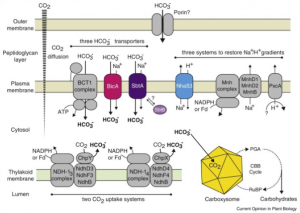DOI: 10.1016/j.pbi.2016.03.002
Cyanobacterial CO2-concentrating mechanism components: Function and prospects for plant metabolic engineering
Abstract
 Highlights:
Highlights:
- Improvement of photosynthesis in C3 crop plants is needed to secure future yields.
- Cyanobacterial CO2-concentrating mechanisms are a potential source to exploit.
- Components of these mechanisms include transporters and RuBisCO micro-compartments.
- Advances include expression of transporters and carboxysome components in plants.
- Current research foci are transporter locations, activation, and RuBisCO folding.
Global population growth is projected to outpace plant-breeding improvements in major crop yields within decades. To ensure future food security, multiple creative efforts seek to overcome limitations to crop yield. Perhaps the greatest limitation to increased crop yield is photosynthetic inefficiency, particularly in C3 crop plants. Recently, great strides have been made toward crop improvement by researchers seeking to introduce the cyanobacterial CO2-concentrating mechanism (CCM) into plant chloroplasts. This strategy recognises the C3 chloroplast as lacking a CCM, and being a primordial cyanobacterium at its essence. Hence the collection of solute transporters, enzymes, and physical structures that make cyanobacterial CO2-fixation so efficient are viewed as a natural source of genetic material for C3 chloroplast improvement. Also we highlight recent outstanding research aimed toward the goal of introducing a cyanobacterial CCM into C3 chloroplasts and consider future research directions.
